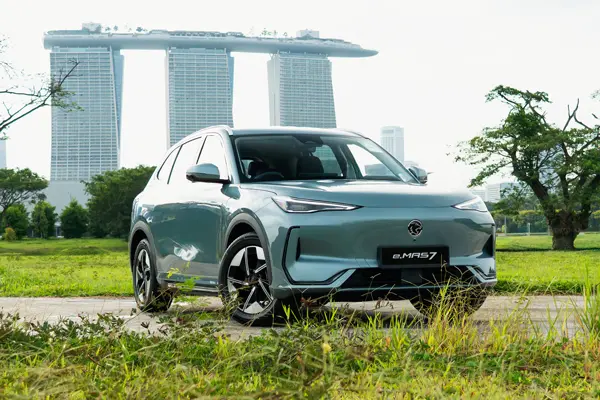The Good 'Ol Days
27 Sep 2016|8,595 views
Modernity and technology is a wonderous thing. We now have things like the iPhone and the Internet, and our lives are surely better for it. But modernity begets change, and change can be a difficult thing to deal with. Not everyone is so keen on the latest technology and the greatest advancements. Some people still pine for the 'good 'ol days', as it were. Even with Spotify and iTunes, some people will still insist that vinyls are the proper way to listen to music. It's the same thing with cars - the so-called 'purists' will insist that cars were better back in the day.
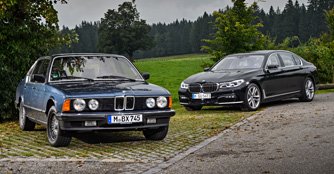
However, on the other hand, we also want to see if modernity and technology have somehow altered the 'essence' of these cars and if that has somehow changed the way BMW makes its cars and the qualities that these cars represent.
Comfort, refinement and luxury - the BMW 7 Series
These are the qualities people would most commonly associate with BMW, and no car embodies these more clearly than the brand's flagship 7 Series, first produced in 1977.
The E23 745i we drove is notable for being the first turbocharged 7 Series. Built in 1983, the level of luxury is impeccable. Velour floor mats and burl wood trim (not veneer, full wood) adorn the luxurious interior. On the road, it is extremely comfortable and easy to drive - steering is light, power is ample (especially if you get past 3,000rpm), and the suspension is soft like butter, great for cruising on highways in an unhurried manner. Get into a few fast corners and the soft suspension definitely hurts, as the car is quite boaty and is a handful to control. But no one drives a 7 Series like that.
The 7 Series also represents advancement - it has always been equipped with the newest and forward-looking technology. The 745i we drove has automatic transmission, automatic air-con, service interval indicators, cruise control, the works. It also has an analogue fuel economy meter, which is incredibly ahead of its time considering the fact that up to maybe five years ago, most carmakers didn't even bother with a feature like that until regulatory bodies started getting involved.
Fast forward 33 years and we have the 750Li xDrive, the pinnacle of BMW technology, comfort, refinement and luxury. It has every modern amenity you could imagine, while still bearing the model's hallmarks - it's easy to drive, sublimely comfortable and quiet, and packs a punch. In this case, there's no doubt that modernity has obvious benefits - technology means things like trick suspension and steering that allows you to go rapidly around corners with minimal body movement. But underneath it all, this is still a supreme luxury vehicle.
 |
Performance and excitement - the M3
Especially when it comes to performance cars, the debate over old versus new rages like no other. Purists will insist that old cars are better driver cars, more engaging and exciting, so on and so forth. The truth is, they are probably right. Driving the E30 M3 and the F80 M3 back to back, there is no doubt that the old car is more engaging, more visceral and more honest. It is sensational in the most literal sense of the word. You are hit with a cascade of sensations - aural, tactile, visual, even the smell of petrol burning.
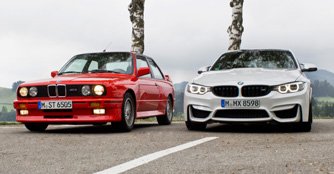
Some will moan that this model ruined the M3 - it's a saloon, it's turbocharged, it's not manual. That's all true. But what technology has done is to bring all of that performance and make it available to everyone. An idiot could drive the M3 fast, and it will still feel exciting. That in itself is a remarkable accomplishment. See a tunnel approach, tap the left paddle shifter twice, wind down your window, and hear the bellow of the 3.0-litre engine. And once you find the cojones to test the car's capabilities (prefereably on a track), you'll find out that is still an immensely capable beast.
Fun and enjoyment - the MINI Cooper
It may wear a different badge, but MINI forms an integral part of BMW's portfolio. Bought over in 1994, BMW had an onus to preserve the inherent character of Mini cars.
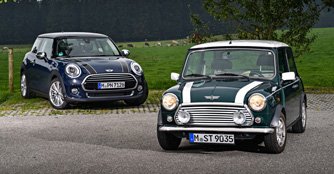
Getting to grips with driving the Mini takes time. The seats aren't adjustable, the steering wheel is awkwardly angled (like an SBS bus), the four gears are oddly spaced, and the three pedals are worryingly close together. However, once you get the hang of it, the car is a blast to drive. Despite only having 62bhp under its bonnet, the feather-light car is a joy to pilot - it feels eager and excitable, and the handling is very responsive. And because the car lacks any kind of technological aid - no anti-lock brakes (ABS), no traction control (TC), nothing - you really have to concentrate when you drive. It demands effort, but that effort is always rewarded.
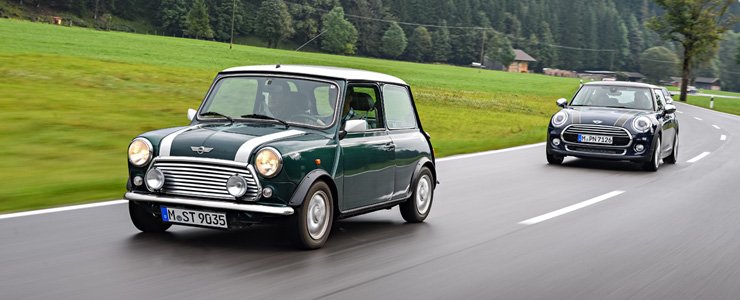 |
The MINI Cooper is a much bigger machine. That's understandable - extra airbags, bigger seats, more boot space, additional safety equipment, these things all need space. However, there is no doubt that the driving sensation remains, and the fun and enjoyment is very much still present. The modern car is certainly easier to drive and more relaxing to drive, but throw it around a couple of corners and it comes alive.
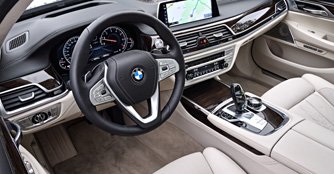
The wind of change
There's no denying that modernity is a good thing. If nothing else, it has made our lives easier and more convenient. And especially for the more mundane and essential things in life, no one will, for a moment, fathom going back to the good 'ol days.
We've moved on from writing letters on parchment with ink and feather to sending emails at a click of a button, and no one will want to revert back to the former. As this drive has proven, it's the same thing with cars. Modern technology has made cars objectively 'better' machines. Features like power steering, air bags, sat nav, Bluetooth, ABS and TC have become essentials in cars that we probably take for granted.
How much has changed? These cars have become bigger, safer, easier to drive, easier to live with, and obviously come kitted out in the latest technology. However, some things haven't changed. The build quality, the sense of impeccable engineering, the driving sensation and connection, these are core BMW qualities that have persisted over time.
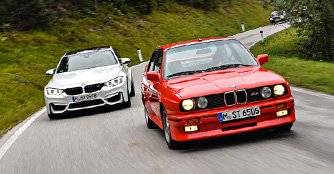
Just like some people will subject themselves to having to flip a vinyl every five tracks instead of listening to an iPod loaded with 5,000 songs, some drivers will swear by classic cars. They want to return to a time where man and machine were one, unhindered by the shackles of technology. There is no doubt that classic cars are much simpler yet more involving to drive, but at the same time much more demanding of the driver.
What this drive has proven is that just because you make something modern does not mean it has to be stripped of its emotional qualities. By balancing the rational and emotional, BMW continues to make cars that are decidedly modern, but still preserving the brand's heritage and each model's inherent qualities. But, in our modern day and age, classic things will always have a place - if only to remind us of our heritage, to offer us the chance to recapture an emotional essentiality, and to see just how far we have come.
Modernity and technology is a wonderous thing. We now have things like the iPhone and the Internet, and our lives are surely better for it. But modernity begets change, and change can be a difficult thing to deal with. Not everyone is so keen on the latest technology and the greatest advancements. Some people still pine for the 'good 'ol days', as it were. Even with Spotify and iTunes, some people will still insist that vinyls are the proper way to listen to music. It's the same thing with cars - the so-called 'purists' will insist that cars were better back in the day.

However, on the other hand, we also want to see if modernity and technology have somehow altered the 'essence' of these cars and if that has somehow changed the way BMW makes its cars and the qualities that these cars represent.
Comfort, refinement and luxury - the BMW 7 Series
These are the qualities people would most commonly associate with BMW, and no car embodies these more clearly than the brand's flagship 7 Series, first produced in 1977.
The E23 745i we drove is notable for being the first turbocharged 7 Series. Built in 1983, the level of luxury is impeccable. Velour floor mats and burl wood trim (not veneer, full wood) adorn the luxurious interior. On the road, it is extremely comfortable and easy to drive - steering is light, power is ample (especially if you get past 3,000rpm), and the suspension is soft like butter, great for cruising on highways in an unhurried manner. Get into a few fast corners and the soft suspension definitely hurts, as the car is quite boaty and is a handful to control. But no one drives a 7 Series like that.
The 7 Series also represents advancement - it has always been equipped with the newest and forward-looking technology. The 745i we drove has automatic transmission, automatic air-con, service interval indicators, cruise control, the works. It also has an analogue fuel economy meter, which is incredibly ahead of its time considering the fact that up to maybe five years ago, most carmakers didn't even bother with a feature like that until regulatory bodies started getting involved.
Fast forward 33 years and we have the 750Li xDrive, the pinnacle of BMW technology, comfort, refinement and luxury. It has every modern amenity you could imagine, while still bearing the model's hallmarks - it's easy to drive, sublimely comfortable and quiet, and packs a punch. In this case, there's no doubt that modernity has obvious benefits - technology means things like trick suspension and steering that allows you to go rapidly around corners with minimal body movement. But underneath it all, this is still a supreme luxury vehicle.
Performance and excitement - the M3
Especially when it comes to performance cars, the debate over old versus new rages like no other. Purists will insist that old cars are better driver cars, more engaging and exciting, so on and so forth. The truth is, they are probably right. Driving the E30 M3 and the F80 M3 back to back, there is no doubt that the old car is more engaging, more visceral and more honest. It is sensational in the most literal sense of the word. You are hit with a cascade of sensations - aural, tactile, visual, even the smell of petrol burning.

Some will moan that this model ruined the M3 - it's a saloon, it's turbocharged, it's not manual. That's all true. But what technology has done is to bring all of that performance and make it available to everyone. An idiot could drive the M3 fast, and it will still feel exciting. That in itself is a remarkable accomplishment. See a tunnel approach, tap the left paddle shifter twice, wind down your window, and hear the bellow of the 3.0-litre engine. And once you find the cojones to test the car's capabilities (prefereably on a track), you'll find out that is still an immensely capable beast.
Fun and enjoyment - the MINI Cooper
It may wear a different badge, but MINI forms an integral part of BMW's portfolio. Bought over in 1994, BMW had an onus to preserve the inherent character of Mini cars.

Getting to grips with driving the Mini takes time. The seats aren't adjustable, the steering wheel is awkwardly angled (like an SBS bus), the four gears are oddly spaced, and the three pedals are worryingly close together. However, once you get the hang of it, the car is a blast to drive. Despite only having 62bhp under its bonnet, the feather-light car is a joy to pilot - it feels eager and excitable, and the handling is very responsive. And because the car lacks any kind of technological aid - no anti-lock brakes (ABS), no traction control (TC), nothing - you really have to concentrate when you drive. It demands effort, but that effort is always rewarded.The MINI Cooper is a much bigger machine. That's understandable - extra airbags, bigger seats, more boot space, additional safety equipment, these things all need space. However, there is no doubt that the driving sensation remains, and the fun and enjoyment is very much still present. The modern car is certainly easier to drive and more relaxing to drive, but throw it around a couple of corners and it comes alive.

The wind of change
There's no denying that modernity is a good thing. If nothing else, it has made our lives easier and more convenient. And especially for the more mundane and essential things in life, no one will, for a moment, fathom going back to the good 'ol days.
We've moved on from writing letters on parchment with ink and feather to sending emails at a click of a button, and no one will want to revert back to the former. As this drive has proven, it's the same thing with cars. Modern technology has made cars objectively 'better' machines. Features like power steering, air bags, sat nav, Bluetooth, ABS and TC have become essentials in cars that we probably take for granted.
How much has changed? These cars have become bigger, safer, easier to drive, easier to live with, and obviously come kitted out in the latest technology. However, some things haven't changed. The build quality, the sense of impeccable engineering, the driving sensation and connection, these are core BMW qualities that have persisted over time.

Just like some people will subject themselves to having to flip a vinyl every five tracks instead of listening to an iPod loaded with 5,000 songs, some drivers will swear by classic cars. They want to return to a time where man and machine were one, unhindered by the shackles of technology. There is no doubt that classic cars are much simpler yet more involving to drive, but at the same time much more demanding of the driver.
What this drive has proven is that just because you make something modern does not mean it has to be stripped of its emotional qualities. By balancing the rational and emotional, BMW continues to make cars that are decidedly modern, but still preserving the brand's heritage and each model's inherent qualities. But, in our modern day and age, classic things will always have a place - if only to remind us of our heritage, to offer us the chance to recapture an emotional essentiality, and to see just how far we have come.
Thank You For Your Subscription.





























